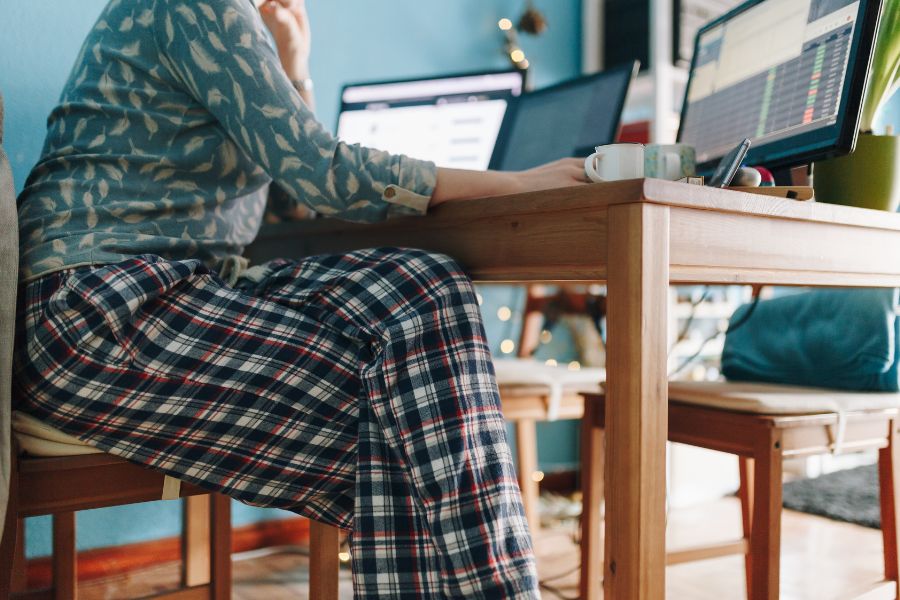The shift to remote work has brought about a more relaxed approach to work attire, with many people opting to work in their pajamas. However, some argue that dressing up for work, even when working from home, can improve focus and productivity.
But which approach is better for maintaining focus and enhancing productivity? This article will compare working from home in pajamas versus dressing up, examining their impact on focus, productivity, mental health, and overall work performance.
By the end, you’ll have a clearer understanding of which approach might be better suited for your remote work lifestyle.
1. The Importance of Work Attire in Remote Work
Before diving into the comparison, it’s important to understand why work attire matters for remote workers. What you wear can influence:
- Mental State: Clothing can affect your mindset and how you approach your work.
- Productivity: The right attire can enhance focus and efficiency.
- Professionalism: Dressing appropriately can help maintain a professional attitude, even at home.
- Work-Life Balance: Establishing a clear separation between work and personal life.
Both working in pajamas and dressing up have their pros and cons, and the best choice depends on your personal preferences and work style.
2. The Case for Working in PJs

Working in pajamas offers comfort and convenience, which can be appealing for many remote workers. Let’s explore the advantages of working in pajamas.
2.1 Comfort and Relaxation
Working in pajamas provides a high level of comfort, which can reduce stress and enhance well-being.
- Physical Comfort: Soft, loose-fitting clothing can make long work hours more comfortable.
- Relaxation: Feeling relaxed can improve overall mood and reduce anxiety.
2.2 Time Savings
Working in pajamas can save time in the morning, allowing you to start work sooner.
- No Morning Routine: Skip the time-consuming process of getting dressed and grooming.
- Quick Start: Transition quickly from waking up to starting work, maximizing your productive hours.
2.3 Flexibility
Working in pajamas offers greater flexibility and freedom in your daily routine.
- Casual Environment: Embrace a more casual and laid-back work environment.
- Personal Preference: Choose clothing that makes you feel comfortable and at ease.
2.4 Cost-Effective
Working in pajamas can be more cost-effective, as it reduces the need for a professional wardrobe.
- No New Clothes: Save money on work attire and dry cleaning.
- Wardrobe Simplification: Simplify your wardrobe and reduce decision fatigue.
2.5 Enhanced Work-Life Balance
Working in pajamas can help create a more relaxed and balanced work environment.
- Casual Atmosphere: Reduce the pressure to maintain a formal work environment.
- Personal Comfort: Prioritize personal comfort and well-being over professional appearance.
3. The Challenges of Working in PJs
While working from home in pajamas offers many benefits, it also comes with challenges that can impact focus and productivity.
3.1 Lack of Professional Mindset
Working in pajamas can make it harder to maintain a professional mindset.
- Mental Shift: The casual attire may blur the line between work and personal life, making it harder to focus.
- Reduced Motivation: Feeling too relaxed can reduce motivation and productivity.
3.2 Distraction and Procrastination
Working in pajamas can lead to increased distraction and procrastination.
- Comfort Zone: Being too comfortable may make it easier to procrastinate or take extended breaks.
- Lack of Structure: The absence of a morning routine can lead to a less structured and focused workday.
3.3 Impact on Mental Health
Working in pajamas can sometimes negatively impact mental health.
- Lack of Routine: Skipping a morning routine can reduce the sense of purpose and structure.
- Self-Esteem: Feeling underdressed may affect self-esteem and confidence.
3.4 Professional Image
Working in pajamas may not project a professional image, particularly for virtual meetings.
- Virtual Meetings: Appearing in pajamas during video calls may not convey professionalism.
- Client Interactions: Dressing casually may not be appropriate for client-facing roles.
3.5 Work-Life Boundaries
Working from home in pajamas can blur the boundaries between work and personal life.
- Separation: The lack of a clear transition between work and personal time can make it harder to disconnect.
- Overwork: Feeling too comfortable may lead to longer work hours and difficulty switching off.
4. The Case for Dressing Up

Dressing up for work, even when working from home, can create a more professional and focused environment. Let’s explore the advantages of dressing up.
4.1 Enhanced Focus and Productivity
Dressing up can help create a professional mindset, enhancing focus and productivity.
- Mental Shift: Putting on work attire can signal the start of the workday, helping you transition into a productive mindset.
- Increased Motivation: Feeling professionally dressed can boost motivation and efficiency.
4.2 Professionalism
Dressing up helps maintain a professional attitude, even in a home environment.
- Virtual Meetings: Appearing well-dressed during video calls conveys professionalism and respect.
- Client Interactions: Dressing appropriately is crucial for client-facing roles and maintaining a professional image.
4.3 Improved Mental Health
Dressing up can positively impact mental health by providing a sense of routine and purpose.
- Morning Routine: Establishing a morning routine that includes getting dressed can create a sense of structure and normalcy.
- Self-Esteem: Feeling well-dressed can boost self-esteem and confidence.
4.4 Work-Life Balance
Dressing up can help create a clear separation between work and personal life.
- Clear Boundaries: Changing into work attire in the morning and out of it in the evening can signal the start and end of the workday.
- Transition: The act of getting dressed can serve as a mental transition between work and personal time.
4.5 Enhanced Professional Image
Dressing up can enhance your professional image, both internally and externally.
- Team Perception: Colleagues and team members may perceive you as more professional and committed.
- Client Trust: Clients may have greater trust and confidence in your abilities when you present yourself professionally.
5. The Challenges of Dressing Up
While dressing up offers many benefits, it also comes with challenges that can impact comfort and convenience.
5.1 Comfort
Dressing up can be less comfortable compared to working in pajamas.
- Physical Discomfort: Formal attire may be less comfortable for long work hours.
- Restrictive Clothing: Tight or restrictive clothing can reduce physical comfort and increase stress.
5.2 Time Investment
Dressing up requires more time and effort in the morning.
- Morning Routine: The process of getting dressed and grooming can be time-consuming.
- Preparation: Requires planning and maintaining a professional wardrobe.
5.3 Cost
Dressing up can be more expensive, particularly if you need to invest in a professional wardrobe.
- Wardrobe Costs: Purchasing and maintaining professional attire can be costly.
- Dry Cleaning: Additional expenses for dry cleaning and maintenance.
5.4 Flexibility
Dressing up offers less flexibility and freedom in your daily routine.
- Casual Days: May feel restricted on days when you prefer a more casual approach.
- Personal Preference: May not align with personal preferences for comfort and relaxation.
5.5 Overemphasis on Appearance
Dressing up can sometimes lead to an overemphasis on appearance over performance.
- Superficial Focus: May prioritize appearance over actual work performance and results.
- Pressure: Feeling pressured to maintain a certain image can increase stress and anxiety.
6. Key Factors to Consider
When choosing between working in pajamas and dressing up, consider the following factors to determine which approach is better for your focus and productivity.
6.1 Personal Preferences
Evaluate your personal preferences and how they align with each approach.
- Comfort Seekers: If you prioritize comfort and relaxation, working in pajamas may be more suitable.
- Professional Mindset: If you value a professional mindset and appearance, dressing up may be more effective.
6.2 Work Requirements
Consider the type of work you do and how each approach supports it.
- Client-Facing Roles: Dressing up is crucial for client-facing roles and virtual meetings.
- Independent Work: Working in pajamas may suffice for independent and less client-focused tasks.
6.3 Mental Health
Think about how each approach impacts your mental health and well-being.
- Routine and Structure: Dressing up can provide a sense of routine and structure, enhancing mental health.
- Relaxation: Working in pajamas can reduce stress and promote relaxation.
6.4 Work-Life Balance
Assess how each approach impacts your work-life balance.
- Clear Boundaries: Dressing up can help create clear boundaries between work and personal time.
- Casual Atmosphere: Working from home in pajamas can create a more relaxed and balanced work environment.
7. Key Takeaways and Recommendations
Deciding between working in pajamas and dressing up depends on your specific needs, preferences, and work requirements.
Here are some key takeaways and recommendations to help you choose.
- Choose Working in PJs If: You prioritize comfort, relaxation, and a casual work environment, and your work does not require a professional appearance.
- Choose Dressing Up If: You value a professional mindset, enhanced focus, and a clear separation between work and personal life, and your work involves client interactions or virtual meetings.
- Consider a Hybrid Approach: Combine both approaches by dressing up for important meetings and working in pajamas for independent tasks, depending on your daily schedule.
Conclusion
The choice between working in pajamas and dressing up ultimately depends on your personal preferences, work requirements, and mental health needs.
Working in pajamas offers comfort, convenience, and a relaxed work environment, making it ideal for those who prioritize relaxation and have less client-focused tasks.
Dressing up while working from home enhances focus, professionalism, and work-life balance, making it suitable for those who value a professional mindset and have client-facing roles.
By carefully evaluating your priorities and testing both approaches, you can select the work attire that best supports your focus, productivity, and overall well-being.
As remote work continues to evolve, having the right work attire in place will be key to thriving in a dynamic and ever-changing work environment.
